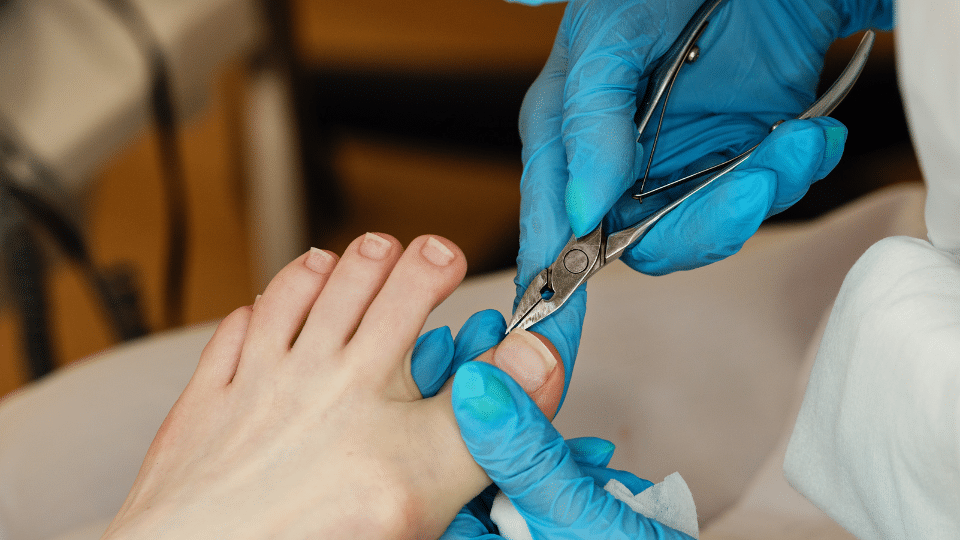Ingrown toenails may seem like a small problem, but anyone who has experienced one knows how painful they can be. When the edge of the nail grows into the surrounding skin, it often leads to redness, swelling, tenderness, and sometimes infection. For many people, ingrown toenails are not a one-time issue but a recurring condition. This raises an important question: are ingrown toenails genetic?
Hereditary factors are only part of the story. Lifestyle, footwear, and nail care habits also significantly influence whether you are more likely to develop ingrown toenails. Understanding both genetic and non-genetic causes can help you prevent painful flare-ups and know when it is time to see a podiatrist.
Are Ingrown Toenails Genetic?
Research and clinical experience suggest that genetics can contribute to the likelihood of developing ingrown toenails. People often inherit certain nail shapes and foot structures from their parents. If your family has a history of toenail problems, you may notice that you experience them as well.
Some hereditary traits linked to ingrown toenails include:
- Nail shape: Nails that are unusually curved or fan-shaped are more prone to digging into the surrounding skin.
- Toe shape and size: If your toes are wider or your nails are proportionally larger than your nail beds, the chance of improper nail growth increases.
- Flat feet or abnormal biomechanics: Inherited foot structures can place additional pressure on the toes, increasing the likelihood of ingrown nails.
So, while not everyone with a family history will develop the condition, the hereditary link answers the common question: are ingrown toenails genetic? Yes, they can be, but genetics are only one part of the equation. If you would like to understand more about why ingrown nails form in the first place and what treatment options are available, explore our detailed blog: The Where To and Why For of Ingrown Nails.
Other Common Causes of Ingrown Toenails

Improper nail trimming
In many cases, the way you trim your toenails can either prevent or trigger ingrown toenails. Cutting them too short or rounding the edges increases the risk of the nail growing into the skin. To lower your chances of recurrence, check out our full guide on Proper Nail Trimming.
Tight footwear
Shoes or socks that squeeze the toes increase pressure on the nails, encouraging them to grow inward.
Injury or trauma
Stubbing your toe or repeated stress from sports can damage the nail and lead to abnormal growth.
Poor foot hygiene
Excessive moisture or fungal infections can alter nail shape and make them more susceptible to becoming ingrown.
Underlying health conditions
Diabetes, obesity, and circulation problems can make the skin around the nail more vulnerable to irritation and infection. Diabetic patients should be particularly cautious, since toenail issues can indicate more serious underlying problems. If you are living with diabetes and notice discoloration or changes in your toenails, read our detailed guide on Understanding Brown Toenails and Diabetes to learn what these changes may mean for your health.
In many cases, hereditary predisposition combined with one or more of these external factors leads to recurring problems.
Symptoms to Watch For
Recognizing the early warning signs of an ingrown toenail is important because prompt treatment can prevent complications. If you are unsure whether you have one, pay attention to these common symptoms:
- Pain and tenderness: The earliest sign is discomfort along one or both sides of the nail. This pain may worsen when wearing shoes, walking, or applying pressure to the toe.
- Swelling and redness: As the nail presses into the surrounding skin, the toe often becomes inflamed. The skin may look puffy or warm to the touch. If you are struggling with persistent swelling in your feet or ankles, our blog on Managing Foot Swelling offers helpful strategies to reduce discomfort and improve circulation.
- Hardened skin or tissue overgrowth: When irritation persists, the body may respond by forming extra tissue around the nail edge. This hardened skin can make the problem more noticeable and painful.
- Drainage or infection: If bacteria enter the area, you may notice yellowish or white discharge, increased redness, throbbing pain, or even pus. At this stage, medical treatment is strongly recommended.
For some people, especially those with underlying health conditions like diabetes, neuropathy, or poor circulation, even a minor ingrown toenail can lead to serious complications. What starts as mild discomfort can quickly progress to a severe infection that threatens overall foot health.
If you notice persistent pain, spreading redness, or any drainage from the toe, it is best to seek podiatric care right away.
Prevention Tips: How to Lower Your Risk
Even if you inherit a tendency toward ingrown toenails, you can take proactive steps to reduce the likelihood of recurrence:
- Trim nails properly: Always cut straight across and avoid rounding the corners too closely.
- Choose the right footwear: Wear shoes with a wide toe box and avoid styles that pinch or squeeze your toes. Shoes that are too tight or narrow place unnecessary pressure on the toes, increasing irritation. To learn more about choosing the right footwear for healthy feet, visit our guide: Shoes, Shoes, Shoes.
- Practice good hygiene: Keep feet clean and dry and treat fungal infections promptly.
- Protect your feet: Use proper footwear during sports and activities to prevent trauma.
- Monitor your toes: If you notice early signs of irritation, do not ignore them. Address the problem before it worsens.
By combining good foot care habits with awareness of hereditary risk, you can significantly lower the frequency and severity of ingrown toenails. Fortunately, there are many ways to reduce your risk of developing painful toenails in the first place. Our podiatrists share practical strategies in this detailed guide: How to Prevent Ingrown Toenails: Expert Tips from a Podiatrist.
Treatment Options for Ingrown Toenails
If preventive measures are not enough, a podiatrist can provide effective treatment. Options may include:
- Conservative care: Soaking the foot, lifting the nail edge, or using protective padding.
- Medical treatment: Addressing infection with antibiotics or antifungal medications if needed.
- Office procedures: In more persistent cases, a podiatrist may perform a minor procedure to remove part of the nail or the root, preventing regrowth in the problem area.
These treatments are quick, safe, and often provide lasting relief, especially for patients who suffer from repeated ingrown toenails.
If your symptoms are getting worse or you are dealing with recurring toenail pain, it is time to consult a podiatrist. Learn more about when it is best to see an Ingrown Toenail Doctor and how professional treatment can relieve discomfort and prevent complications.
Taking Control of Ingrown Toenails
So, are ingrown toenails genetic? Yes, they can be. Inherited nail shapes, toe structures, and foot biomechanics may make you more prone to the condition. However, daily habits, footwear choices, and proper nail care play just as large a role.
At Fall Creek Foot & Ankle, we understand how frustrating recurring ingrown toenails can be. Whether your problem is hereditary, lifestyle-related, or a combination of both, our podiatry experts can help you find relief and prevent future recurrences.
If you have been dealing with painful or recurring ingrown toenails, professional care can make all the difference. Schedule an appointment with Fall Creek Foot & Ankle today and let our specialists provide the personalized treatment you need to stay comfortable and active.
